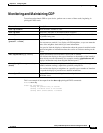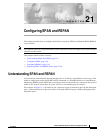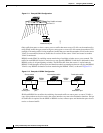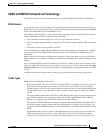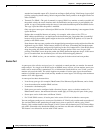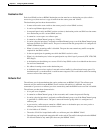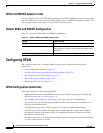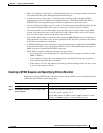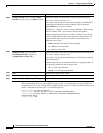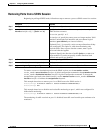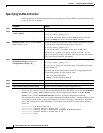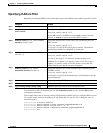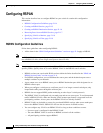
21-7
Catalyst 2950 Desktop Switch Software Configuration Guide
78-14982-01
Chapter 21 Configuring SPAN and RSPAN
Understanding SPAN and RSPAN
SPAN and RSPAN Interaction with Other Features
SPAN interacts with these features:
• Routing—Ingress SPAN does not monitor routed traffic. VSPAN only monitors traffic that enters
the switch, not traffic that is routed between VLANs. For example, if a VLAN is being
Rx-monitored and the multilayer switch routes traffic from another VLAN to the monitored VLAN,
that traffic is not monitored and not received on the SPAN destination port.
• Spanning Tree Protocol (STP)—A destination port or a reflector port does not participate in STP
while its SPAN or RSPAN session is active. The destination or reflector port can participate in STP
after the SPAN or RSPAN session is disabled. On a source port, SPAN does not affect the STP status.
STP can be active on trunk ports carrying an RSPAN VLAN.
• Cisco Discovery Protocol (CDP)—A SPAN destination port does not participate in CDP while the
SPAN session is active. After the SPAN session is disabled, the port again participates in CDP.
• VLAN Trunking Protocol (VTP)—You can use VTP to prune an RSPAN VLAN between switches.
• VLAN and trunking—You can modify VLAN membership or trunk settings for source, destination,
or reflector ports at any time. However, changes in VLAN membership or trunk settings for a
destination or reflector port do not take effect until you disable the SPAN or RSPAN session.
Changes in VLAN membership or trunk settings for a source port immediately take effect, and the
respective SPAN sessions automatically adjust accordingly.
• EtherChannel—You can configure an EtherChannel group as a source port but not as a SPAN
destination port. When a group is configured as a SPAN source, the entire group is monitored.
If a port is added to a monitored EtherChannel group, the new port is added to the SPAN source port
list. If a port is removed from a monitored EtherChannel group, it is automatically removed from
the source port list. If the port is the only port in the EtherChannel group, the EtherChannel group
is removed from SPAN.
If a physical port that belongs to an EtherChannel group is configured as a SPAN source, destination,
or reflector port, it is removed from the group. After the port is removed from the SPAN session, it
rejoins the EtherChannel group. Ports removed from an EtherChannel group remain members of the
group, but they are in the down or standalone state.
If a physical port that belongs to an EtherChannel group is a destination or reflector port and the
EtherChannel group is a source, the port is removed from the EtherChannel group and from the list
of monitored ports.
• QoS—For ingress monitoring, the packets sent to the SPAN destination port might be different from
the packets actually received at the SPAN source port because the packets are forwarded after
ingress QoS classification and policing. The packet DSCP might not be the same as the received
packet.
For egress monitoring, the packets sent out the SPAN destination port might not be the same as the
packets sent out of SPAN source ports because the egress QoS policing at the SPAN source port
might change the packet classification. QoS policing is not applied at SPAN destination ports.
• Multicast traffic can be monitored. For egress and ingress port monitoring, only a single unedited
packet is sent to the SPAN destination port. It does not reflect the number of times the multicast
packet is sent.
• A secure port cannot be a SPAN destination port.
• You can enable 802.1X on a port that is a SPAN destination or reflector port; however, 802.1X is
disabled until the port is removed as a SPAN destination or reflector port. You can enable 802.1X
on a SPAN source port.



